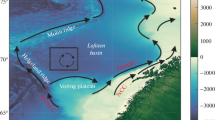Summary
A three-dimensional numerical model based on the primitive equations is applied to a limited region of the North Sea off the English coast near Flamborough Head. In summer, this area contains a tidal mixing front between stratified water to the north and well-mixed water to the south. The model is given as initial conditions a stratification dependent on the depth. As the density structure is allowed to evolve over a few days meanders and eddies are formed. It is shown that both friction and the presence of bathymetry tend to suppress eddy growth. Results with different horizontal resolution are compared.
Zusammenfassung
Ein dreidimensionales numerisches Modell, das auf den primitiven Gleichungen basiert, wird auf ein begrenztes Gebiet der Nordsee vor der englischen Küste in der Nähe von Flamborough Head angewandt. Im Sommer liegt in diesem Gebiet eine Flachwasserfront, die geschichtetes Wasser im Norden von durchmischtem Wasser im Süden trennt. Als Anfangsverteilung wird dem Modell eine Schichtung in Abhängigkeit von der Tiefenverteilung vorgegeben. Da es dem Dichtefeld gestattet ist sich zu entwickeln, entstehen für wenige Tage Mäander und Wirbel. Es wird gezeigt, daß sowohl Reibung als auch Topographie die Eigenschaft haben, das Anwachsen der Wirbel zu begrenzen. Des weiteren werden Ergebnisse mit unterschiedlicher horizontaler Auflösung verglichen.
Résumé
Un modèle tridimensionnel fondé sur les équations primitives est appliqué à une zone particulière de la Mer du Nord au large de la Côte anglaise près de Flamborough Head. En été, dans cette zone existe un front lié à la marée et séparant une eau stratifiée au Nord et une eau bien mélangée au Sud. Les conditions initiales fournies au modèle sont une stratification fonction de la profondeur. Comme la structure des densités peut évoluer sur plusieur jours, il y a formation de méandres et tourbillons. On montre que la friction et la topographie du fond peuvent empêcher la croissance des tourbillons. Les résultats avec différentes résolutions horizontales sont comparés.
Similar content being viewed by others
References
Flagg, C. N. and R. C. Beardsley, 1978: On the stability of the shelf water/slope water front south of New England. J. geophys. Res.,83, 4623–4632.
Heijst, G. J. F. van, 1986: On the dynamics of a tidal mixing front. In: J. C. J. Nihoul (Ed.), Marine interfaces ecohydrodynamics. Amsterdam: Elsevier, 165–194. (Elsevier Oceanography Series,43.)
James, I. D., 1984: A three-dimensional numerical shelf-sea front model with variable eddy viscosity and diffusivity. Cont. Shelf Res.,3, 69–98.
James, I. D., 1986: A front-resolving sigma coordinate sea model with a simple hybrid advection scheme. Appl. math. Modelling,10, 87–92.
James, I. D., 1987: A general three-dimensional eddy-resolving model for stratified seas. In: J. C. J. Nihoul and B. M. Jamart (Eds.), Three-dimensional models of marine and estuarine dynamics. Amsterdam: Elsevier, 591–608. (Elsevier Oceanography Series,45.)
James, I. D., 1988: Experiments with a numerical model of coastal currents and tidal mixing fronts. Cont. Shelf Res.,8, 1275–1297.
Kesel, P. G. and F. J. Winninghof, 1972: The Fleet Numerical Weather Central operational primitive equation model. Mon. Weath. Rev.,100, 360–373.
Lorenzzetti, J. A. and J. D. Wang, 1986: On the use of wave-absorbing layers in the treatment of open boundaries in numerical coastal circulation models. Appl. math. Modelling,10, 339–345.
Martinsen, E. A. and H. Engedahl, 1987: Implementation and testing of a lateral boundary scheme as an open boundary condition in a barotropic ocean model. Coastal Eng.,11, 603–627.
Perkey, D. J. and C. W. Kreitzberg, 1976: A time-dependent lateral boundary scheme for limited-area primitive equation models. Mon. Weather Rev.,104, 744–755.
Shapiro, R., 1970: Smoothing, filtering and boundary effects. Rev. Geophys. Space Phys.,8, 359–387.
Sundström, A. and T. Elvius, 1979: Computational problems related to limited area modelling. In: Numerical methods used in atmospheric models, Vol. II. ICSU/WMO, 379–416. (GARP Publications Series,17.)
Author information
Authors and Affiliations
Rights and permissions
About this article
Cite this article
James, I.D. A three-dimensional model of circulation in a frontal region of the North Sea. Deutsche Hydrographische Zeitschrift 42, 231–247 (1989). https://doi.org/10.1007/BF02226296
Received:
Accepted:
Published:
Issue Date:
DOI: https://doi.org/10.1007/BF02226296




